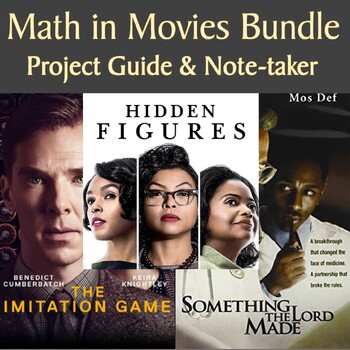Math in Movies Activity Project Guide & Notetaker PBL with Math Practices Bundle
- Zip
What educators are saying
Products in this Bundle (3)
Description
Get students excited about real world mathematics using compelling major motion pictures! Each student will complete a movie note-taker specific to their assigned character. Once the movie is complete, students will gather in groups of four, one representing each movie character, to reflect on the movie and share impressions from the point of view of their character. “Good note-taking templates to use while my students viewed the film. Allowed students to discuss the film from different perspectives.” -STEMtastic Teaching
Step out of the classroom and into math history with these three captivating movies. You will love the thoughtful discussions prompted by the Movie Reflections Guide as students merge the four points of view from the movie. Progress comes at a price to its pioneers. Time will fly while students dive deep into the issues of these math movies spanning time from The Great Depression to The Space Race.
This Bundle Includes:
These movies and their accompanying materials are suited for students in grades 7 through 12. Although prepared for classroom use, each movie can be completed independently if you have a student who is absent and has access to the movie. These lessons also make excellent sub plans. Each movie activity project takes three 60-minute blocks or two 90-minutes blocks to complete.
Included materials for each movie:
- Teacher Instructions
- Movie Note-taker (4 editions)
- Movie Reflection Handout
- Six Extension Idea
- Five DOK-4 Questions
- Answer Keys (5)
***********************************************************************************************************
What other teachers are saying…
“My students loved this activity so very much! We used it to create a cross-curricular experience for Math, Science, and Social Studies Classes. I loved that I could use it with a sub while I was out of the classroom and relate it to the real world.” – Linda Zuniga (Hidden Figures)
“My students loved the movie and the note taking sheet kept them focused. I really liked that the students were able to focus on different points of view.” – Bethany S (Something the Lord Made)
“I love this resource and the idea for projects that spiral from it! Watching Hidden Figures during Black History Month - such an amazing movie.” -Nahida A (3 Movie Bundle)
***********************************************************************************************************
Other resources from Absolute Value that you may like….
Probability Challenge with Skittles
Buy Your First Car Mastery Task
**************************************************************************************************
Customer Tips: How to get TPT credit for future purchases
Go to your “My Purchases” page. Next to each purchase, you'll see a “Provide Feedback” button. Simply click it and you will be taken to a page where you can give a quick rating and leave a short comment for the product. Each time you give feedback, TPT gives you feedback credits that you may use to lower the cost of your future purchases. We'd really love it if you'd rate our item after downloading! Feedback is so VERY important!
**************************************************************************************************
Follow my Store
Click on the green star next to our store logo to receive upcoming sales, freebie and product launches, and email updates!
Here's to a successful year!
Absolute Value
Petty415@gmail.com
For more Project Based Learning with Mathematics available at my store: https://www.teacherspayteachers.com/Store/Absolute-Value. This project was created and provided by Absolute Value.





